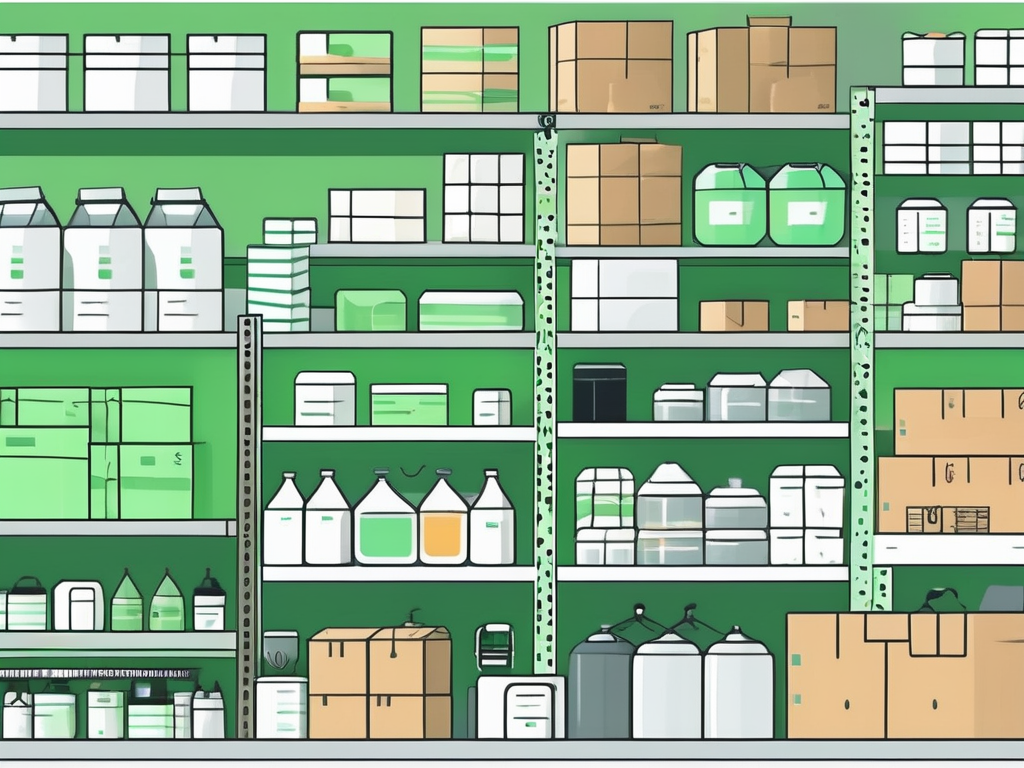Share this
Understanding What Merchandise Inventory Includes
by Shipfusion Team on Jan. 10, 2025

For retail and wholesale businesses, merchandise inventory is more than just a collection of products—it's the engine driving revenue and customer satisfaction. Mismanagement can lead to overstocks, shortages, or missed opportunities, while effective strategies unlock growth and profitability. This comprehensive guide demystifies merchandise inventory, breaking down its components, valuation methods, and management challenges to empower businesses with actionable insights. By mastering these principles, companies can streamline operations, reduce costs, and deliver better experiences to their customers.
Defining Merchandise Inventory
Merchandise inventory refers to the goods that a business holds for the purpose of resale. This includes products that are finished and ready to be sold, as well as items that are still in the process of being manufactured or assembled. In simpler terms, it encompasses all products on the shelves and in the back storage areas of a business.
The Basics of Merchandise Inventory
At its core, merchandise inventory is a critical asset on a company’s balance sheet. It reflects the total value of products owned at a specific point in time and represents a major portion of a retailer's total assets. Businesses often categorize their inventory based on its state—raw materials, work-in-progress, and finished goods—to streamline management and operations.
This categorization not only aids in tracking the flow of goods but also helps in forecasting future inventory needs based on sales trends and seasonal demands. Attributes such as turnover rates, lead times, and holding costs play a pivotal role in inventory management. Retailers must ensure they maintain optimal inventory levels to meet customer demand without incurring excess holding costs.
For instance, a high turnover rate indicates that products are selling quickly, which can be a sign of effective inventory management. Conversely, a low turnover rate may suggest overstocking or a lack of customer interest, prompting businesses to reassess their purchasing strategies.
Why Accurate Inventory Management Is Important
Accurate inventory management is vital for any retail operation. Inaccuracies can lead to lost sales, customer dissatisfaction, and increased operational costs. For instance, if a retailer underestimates its inventory needs, it may run out of popular items, leading to missed sales opportunities.
On the other hand, overstocking can result in markdowns and cash flow problems. This delicate balance is crucial, especially in industries where trends can shift rapidly, making it essential for businesses to remain agile and responsive to market changes.
Additionally, businesses that invest in advanced inventory management systems and regular audits can improve accuracy. This ultimately fosters better decision-making and provides a clearer picture of business health. By leveraging technologies such as RFID and barcode scanning, retailers can enhance their tracking capabilities, ensuring that inventory records are up-to-date and reflective of actual stock levels.
Furthermore, integrating inventory management with sales data can provide insights into customer preferences, enabling businesses to tailor their offerings and promotions effectively, thus optimizing both inventory turnover and customer satisfaction.
Components of Merchandise Inventory
Understanding the different components of merchandise inventory allows businesses to strategize more effectively around production, purchasing, and sales. Each category plays a unique role in the overall inventory management process.
Raw Materials and Supplies
Raw materials are the basic components used in the manufacturing of products. In a retail environment focused on reselling, these might not be as prevalent unless the retailer is involved in some form of manufacturing. For instance, a furniture retailer that creates custom pieces will need to track wood, fabrics, and other materials as part of their inventory.
Accurate records of raw materials help businesses gauge production schedules and costs, significantly impacting overall profitability. Additionally, fluctuations in raw material prices can directly affect a company's bottom line, making it crucial for businesses to establish strong relationships with suppliers and stay informed about market trends. By leveraging technology, such as inventory management software, companies can automate tracking and forecasting, ensuring they maintain optimal levels of raw materials while minimizing waste.
Work-in-Progress Inventory
Work-in-progress (WIP) inventory includes items that have started the manufacturing process but are not yet finished. This category is essential for businesses that have complex workflows. For example, an electronics manufacturer might have partially assembled components on hand as part of its WIP inventory.
Managing WIP effectively can ensure that production flows smoothly, thereby reducing delays and enabling timely deliveries to customers. Moreover, understanding the stages of WIP can provide insights into production efficiency and bottlenecks. By analyzing the time taken at each stage, businesses can identify areas for improvement, optimize labor allocation, and implement lean manufacturing principles to enhance overall productivity.
Finished Goods Inventory
Finished goods are products that are completed and ready for sale. For a retail business, this is the most visible aspect of merchandise inventory, as these items are displayed on shelves and available to customers. It’s important to maintain an adequate level of finished goods to meet consumer demand without overstocking. Monitoring sales trends can help retailers adjust their finished goods inventory accordingly. For example, seasonal products may require close attention during peak buying periods.
Additionally, effective inventory turnover ratios can indicate how well a business is managing its finished goods. Retailers can utilize data analytics to forecast demand more accurately, ensuring they stock the right products at the right time. This proactive approach not only enhances customer satisfaction but also minimizes the risk of markdowns on unsold inventory, ultimately driving better financial performance.
The Role of Merchandise Inventory In Retail
Merchandise inventory serves multiple functions in a retail context. It is an essential aspect that influences sales, operational efficiency, and customer satisfaction.
Inventory Management In Retail
Effective inventory management involves overseeing stock levels, product deliveries, and order placement. Retailers often utilize various inventory management techniques to optimize these processes. Techniques such as Just-In-Time (JIT) inventory ensure that stock is only ordered as needed, reducing holding costs.
Moreover, using technology, such as inventory management software, streamlines operations by allowing real-time monitoring of stock levels. Automated alerts can notify managers when stock is low, enabling timely reordering. This technological integration not only enhances accuracy but also minimizes human error, which can lead to overstocking or stockouts.
Additionally, many retailers are adopting advanced analytics to predict inventory needs based on historical sales data, seasonal trends, and consumer behavior, further refining their inventory strategies.
Impact on Sales and Profitability
Merchandise inventory has a direct impact on a retailer's sales and profitability. Having the right products in stock can drive sales, whereas stockouts can frustrate customers and lead them to competitor stores. For example, retailers often experience a spike in sales during holiday seasons, necessitating careful inventory planning ahead of time to capture consumer spending.
Moreover, the manner in which inventory is valued can affect financial statements, influencing key metrics like gross margin and net profit. Efficient inventory management reduces costs and lowers the risk of stock obsolescence, thereby bolstering profitability. Retailers also need to consider the impact of consumer preferences and market trends on their inventory.
For instance, the rise of sustainable and ethically sourced products has prompted many retailers to adjust their inventory to meet changing consumer demands, which can enhance brand loyalty and drive sales. By aligning inventory strategies with consumer values, retailers can not only improve their bottom line but also foster a positive brand image in an increasingly conscious marketplace.
Merchandise Inventory Valuation Methods
Valuing inventory accurately is essential for financial reporting and decision-making. Several methods can be employed, each with distinct implications for financial statements.
First-In, First-Out (FIFO) Method
The FIFO method assumes that the oldest items in inventory are sold first. This approach is particularly relevant in industries where product expiry is a concern, such as food and pharmaceuticals. FIFO typically leads to lower cost of goods sold during inflation, reflecting recent higher prices in the balance sheet.
For example, a grocery store using FIFO will sell the oldest food items first, which helps in minimizing waste due to perishable inventory. Additionally, FIFO can enhance a company's cash flow management by ensuring that older stock is rotated out efficiently, thereby reducing the risk of spoilage and associated losses. This method also aligns with consumer expectations, as customers often prefer to purchase fresher products.
In industries where brand reputation hinges on product quality, such as cosmetics and health supplements, FIFO can be a strategic choice that reinforces customer trust.
Last-In, First-Out (LIFO) Method
Conversely, the LIFO method posits that the most recently acquired items are sold first. While this method may reduce tax liabilities during inflation by showing higher costs of goods sold, it can complicate financial analysis and may not reflect current market conditions accurately. Some retailers may prefer LIFO for its cash flow advantages, especially in volatile market conditions, but it’s critical to understand the implications for financial reporting.
For instance, in industries like oil and gas, where prices can fluctuate dramatically, LIFO can provide a more favorable tax position during periods of rising costs. However, companies using LIFO vs. FIFO may face challenges in inventory valuation on their balance sheets, as the remaining inventory may be valued at older, lower costs, potentially misleading investors about the company's current financial health.
Furthermore, LIFO is not permitted under International Financial Reporting Standards (IFRS), which can limit its applicability for companies operating globally.
Weighted Average Cost Method
The Weighted Average Cost (WAC) method calculates an average cost of all inventory items and allocates this average to the cost of goods sold and ending inventory. This approach smooths out price fluctuations, providing a balanced view of inventory costs over time. Retailers often find this approach useful in industries with significant volatility in purchasing prices for inventory, making it easier to maintain consistent pricing strategies and reporting.
By averaging costs, companies can avoid the extremes of FIFO and LIFO, creating a more stable financial picture that can be appealing to investors and stakeholders. This method is particularly advantageous for businesses with large volumes of similar items, such as manufacturing or bulk retail, where tracking individual item costs can be cumbersome. Additionally, the weighted average cost method can simplify inventory management processes, as it reduces the need for constant price tracking and allows for more straightforward financial forecasting and budgeting.
Challenges In Managing Merchandise
Inventory Despite its importance, managing merchandise inventory comes with a host of challenges that can hinder operational effectiveness. Awareness of these obstacles enables businesses to proactively tackle them.
Overstocking and Understocking Issues
Overstocking leads to higher holding costs, such as storage fees and potential markdowns. Conversely, understocking can cause lost sales and dissatisfied customers. Striking the right balance is often difficult, especially in rapidly changing markets. Retailers must employ sophisticated forecasting techniques to predict demand accurately. For instance, using historical sales data combined with market trends can help businesses anticipate inventory needs more effectively and adjust purchasing strategies accordingly.
Inventory Shrinkage Concerns
Inventory shrinkage is a significant concern for retailers, leading to losses that can affect overall profitability. It often results from theft, damage, or accounting errors. Retailers have been known to implement security measures and regular audits to minimize shrinkage. For example, introducing cameras in aisles or employing loss prevention personnel can deter theft. Additionally, using technology, such as RFID (Radio Frequency Identification), can help in tracking inventory more accurately throughout the supply chain.
Technological Challenges In Inventory Management
The increasing reliance on technology in inventory management also introduces challenges. Issues such as software updates, data integration, and staff training can complicate operations. Businesses may face difficulties in adapting to new systems or technologies if staff members are not adequately trained. Investment in staff education and technology that integrates smoothly with existing systems is imperative to maximize the benefits of advanced inventory management solutions.
What Solutions for Merchandise Inventory with Shipfusion Include
Whether you’re fine-tuning reorder points or adopting cutting-edge technologies, optimizing inventory can transform how your business operates. At Shipfusion, we specialize in inventory solutions that help ecommerce businesses thrive. Get the tools you need to scale with confidence, from real-time tracking to tailored warehouse management and beyond.
Contact us today to learn how Shipfusion can elevate your inventory strategy and unlock new growth opportunities.
Share this
You May Also Like
These Related Articles

What Is an RFID Warehouse Management System, and Do You Need One?

Inventory Insurance: Why It Matters for Your Business

Cushion Inventory and Why It’s So Important
- October 2025 (1)
- September 2025 (6)
- August 2025 (8)
- July 2025 (16)
- June 2025 (22)
- May 2025 (27)
- April 2025 (27)
- March 2025 (26)
- February 2025 (26)
- January 2025 (34)
- December 2024 (16)
- November 2024 (22)
- October 2024 (22)
- September 2024 (27)
- August 2024 (9)
- July 2024 (8)
- June 2024 (5)
- May 2024 (8)
- April 2024 (7)
- March 2024 (6)
- February 2024 (6)
- January 2024 (5)
- December 2023 (3)
- November 2023 (3)
- October 2023 (5)
- September 2023 (4)
- August 2023 (2)
- July 2023 (1)
- June 2023 (4)
- March 2023 (2)
- October 2022 (1)
- September 2022 (5)
- August 2022 (4)
- July 2022 (7)
- June 2022 (4)
- May 2022 (4)
- April 2022 (6)
- March 2022 (2)
- February 2022 (1)
- January 2022 (3)
- December 2021 (2)
- November 2021 (4)
- October 2021 (2)
- September 2021 (5)
- August 2021 (4)
- July 2021 (4)
- June 2021 (3)
- May 2021 (2)
- April 2021 (3)
- March 2021 (3)
- February 2021 (3)
- January 2021 (2)
- December 2020 (4)
- November 2020 (2)
- October 2020 (4)
- September 2020 (2)
- July 2020 (5)
- June 2020 (4)
- May 2020 (2)
- April 2020 (2)
- March 2020 (4)
- February 2020 (1)
- December 2019 (1)
- May 2018 (1)
- March 2018 (2)
- February 2018 (3)
- January 2018 (3)
- November 2017 (3)
- July 2017 (4)
- March 2017 (3)
- February 2017 (5)
- January 2017 (3)
- December 2016 (4)
- November 2016 (6)
- October 2016 (6)
- October 2015 (1)
- September 2015 (1)
- June 2015 (3)
- May 2015 (3)
- August 2014 (1)
- July 2014 (1)
- March 2014 (1)
- February 2014 (1)